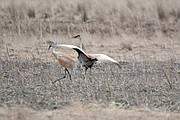Sandhill cranes: Among nature’s greatest dancers
“To the east that early morning, strange dashes of red color shone through the blowing tops of prairie sedges where the sun touched the crowns of Sandhill cranes. That blood-red glint of life in the brown grasslands, that long calling — why should such fleeting moments pierce the heart? And yet they do.”
— Peter Matthiessen (American novelist and naturalist, 1927-2014)
Last week while observing at the Kootenai National Wildlife Refuge I viewed a great wildlife spectacle, the dance of the sandhill crane. Two cranes performed dancing displays involving wing-flapping, bowing, turning their back on each other, jumping and one threw some grass in the air. They continued this courtship dance while totally ignoring me. That was a display that I won’t soon forget.
Standing four feet tall with a six-foot-wide wingspan, just one sandhill crane is an impressive sight. However, every fall and spring, Idaho offers opportunities to see hundreds of the cranes migrate.
Sandhill cranes (Antigone canadensis) are large birds with long, thin legs and necks. They are the smaller of two cranes, the other being the endangered whooping crane. The bird’s cheeks are white and its forehead has a bright red patch, which is one of the bird’s most noticeable features.
Sandhill cranes have mostly grayish feathers, but the shade of gray can vary widely. Although the feathers are gray, sometimes they can have a reddish-brown appearance. This is because sandhill cranes preen themselves by rubbing mud on their feathers and mud from iron-rich environments is often red. Cranes fly with their heads and feet extended, which can identify them compared to the similar great blue herons.
Love is in the air when it comes to courtship. Sandhill cranes pull out all the stops, using elaborate displays to attract a potential mate and outdo the competition. Cranes are elegant dancers. Dancing peaks during mating season but can occur any time of year. Experts do not completely understand the behavior, but it seems to play a role in bonding.
Mated sandhill cranes also sing a unison call during courtship. Curiously, young birds also dance — believed to be an important part of their motor development. Humans have admired crane dancing for centuries; many cultures have symbolic rituals that mimic the behavior.
Sandhill cranes mate for life or until one of the cranes dies. After a mate passes away, the surviving crane will seek out a new mate. In the early spring, as Sandhill cranes are migrating to their breeding grounds, single cranes will start pairing up. The loudest and most noticeable call made by a sandhill crane is during the mating season. Males and females will perform unison calling to create a bond.
When the pair reaches the northern breeding grounds, they mate and build a nest. Cranes build a ground nest out of plant materials. They often have two eggs. The pair will take care of the nest together with the male standing guard.
It takes about a month for the eggs to hatch and more than two months for the chicks to be independent. In the fall, the juvenile sandhill cranes migrate south with their parents. After two years, the juvenile cranes reach sexual maturity and begin the search to find their own mates. Sandhill cranes in the wild have a greater chance of dying young, but these cranes can live for 20 years of more.
Sandhill cranes spend most of their lives in freshwater wetlands, including marshes, wet grasslands and river basins. The sandhill cranes spend winters in the south and summers at the breeding grounds. The cranes winter in Texas, California, Arizona, New Mexico and Mexico. In the early spring, they begin the migration to their breeding grounds. Throughout the spring, the cranes can be seen resting and feeding along rivers and wetlands in the Great Plains and Pacific Northwest.
The largest congregation of Sandhill cranes occurs from February to early April along the Platte River in Nebraska. During the late spring, summer, and early fall, sandhill cranes can be seen at their breeding grounds. Some breed in Minnesota, Wisconsin, and Michigan. Others breed in Oregon, Idaho and Alaska.
Cranes are active throughout the day, but some of the best times to see them flying are dawn and dusk. Make sure you bring your binoculars and dress for chilly spring mornings.
Enjoy Boundary County and all its birds both resident and those visiting on spring migration.



